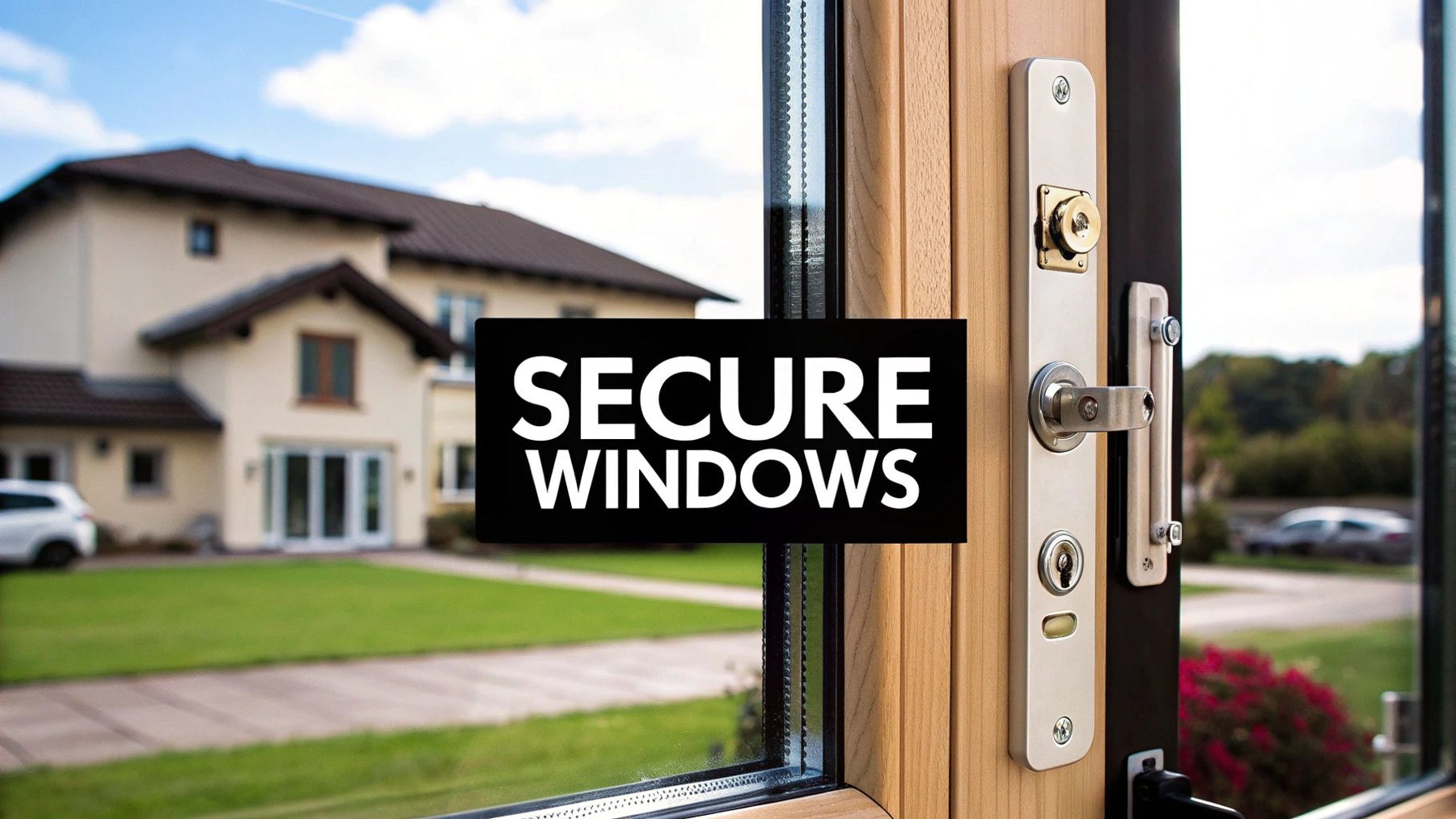
How to Secure Your Windows: A Complete Guide for Homeowners
Knowing how to secure your windows is one of the most critical steps in protecting your home. It’s not about one magic solution but layering your defenses, starting with simple, effective fixes. Reinforcing existing locks, adding visual deterrents, and making smart landscaping choices can significantly boost your home's security without a major investment.
This guide will walk you through the essential layers of window security, from basic hardware upgrades to advanced smart technology, helping you make your home a much harder target for intruders.
Table of Contents
- Why Window Security Should Be Your Top Priority
- Choosing the Right Window Locks and Hardware
- Reinforcing Glass With Security Window Film
- Integrating Smart Technology for Modern Security
- Advanced Window Security Tactics for Maximum Protection
- Frequently Asked Questions About How to Secure a Window
Why Window Security Should Be Your Top Priority
When we think about home security, our minds often jump to the front door. However, FBI data reveals a crucial vulnerability: nearly a quarter of all burglaries occur through a first-floor window. This makes learning how to secure your windows an essential part of keeping your home and family safe.
An unsecured window, especially one hidden on the side or back of your house, is a prime target.
Intruders look for the path of least resistance. A flimsy factory latch, an overgrown shrub offering cover, or a window left slightly ajar are the exact opportunities they seek. Your goal isn't just to make entry difficult; it's to make it so loud, time-consuming, and risky that a burglar decides your home isn't worth the trouble and moves on.
The Mindset of an Intruder
To outsmart an intruder, you must first think like one. They typically scan for three things:
- Easy Access: Can they reach and open the window without much effort?
- Low Visibility: Can they work on the window without being seen by neighbors or passersby?
- Quick Entry: Can they get in and out within a few minutes?
Your primary job is to disrupt that plan. Every security layer you add—from a better lock to a thorny bush under the sill—complicates their strategy and increases their risk of getting caught.
Auditing your home's vulnerabilities doesn't require expensive gadgets. Simply walk around your property and view it from the street and your neighbor's yard. Where are the shadows? Which windows are hidden from view? Those are your starting points.
For more strategies, these top security tips for securing windows from break-ins offer a great overview of your options.
Window Security Layers at a Glance
Think of your security strategy as building a defense in layers, where each one supports the others. This table breaks down how to prioritize your efforts.
| Security Layer | Primary Goal | Example Methods |
|---|---|---|
| Basic (Deterrence) | Make your home look like a difficult target. | Visible locks, security system signs, thorny landscaping. |
| Intermediate (Reinforcement) | Strengthen the window's weakest points. | Upgraded locks, sash pins, window security film. |
| Advanced (Detection) | Alert you to an attempted or successful breach. | Glass break sensors, contact sensors on the frame. |
Starting with basic deterrence and working your way up is the most practical and effective approach.
Choosing the Right Window Locks and Hardware
The standard latches on most windows offer a false sense of security. They are designed for a weather-tight seal, not to stop a determined intruder. Upgrading your window hardware is one of the most direct and effective ways to fortify these weak points.
This infographic drives home why focusing on your windows is so critical.
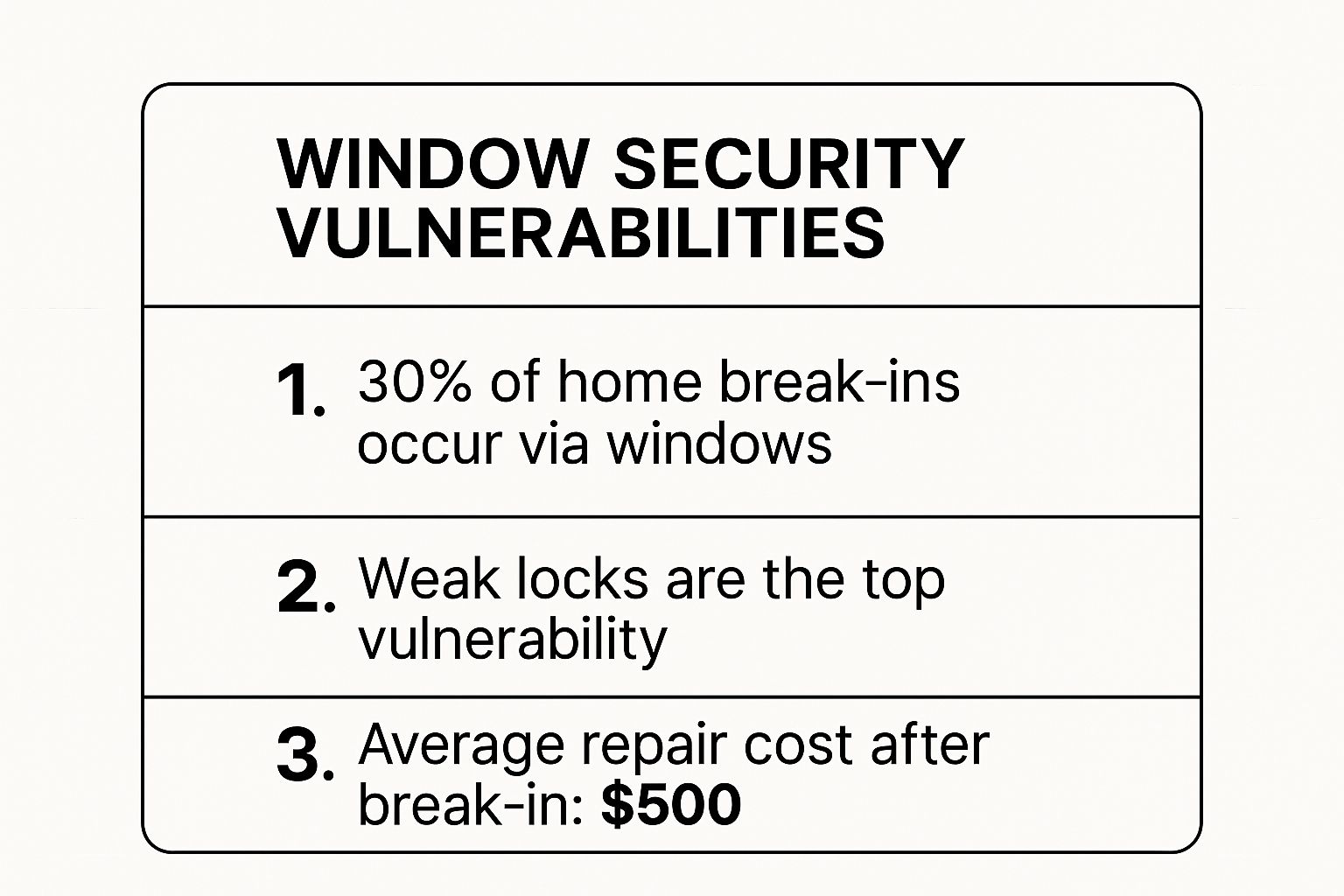
Alt text: Infographic showing that 30% of burglars enter through a window, a key reason to learn how to secure window hardware.
The numbers don't lie. A staggering 30% of burglars get in through a window, often because the factory hardware failed. That's a vulnerability that can cost you dearly, with the average repair hitting $500.
Locks for Double-Hung and Single-Hung Windows
Classic vertical sliding windows are common, but their crescent-shaped latches can often be jiggled open from the outside. Fortunately, you have much better options to secure them.
- Keyed Locks: These function like a deadbolt for your window. You need a key to open them from the inside, which prevents an intruder from smashing a small pane of glass to reach in and flip the lock.
- Flip Locks: Also known as sash locks, these are simple yet highly effective secondary locks. Mounted on the lower sash, a small lever flips over the upper sash, physically blocking it from moving.
- Window Pin Locks: A low-tech but tough solution. You drill a hole through the first sash and partway into the second, then insert a steel pin to lock them together, making it nearly impossible to force open.
Securing Casement and Awning Windows
Casement windows, which crank outward, are generally more secure because their locking mechanism is embedded in the frame. The main weak point can be the crank mechanism itself if an intruder can apply enough leverage.
Insider Tip: For casement windows, focus on reinforcing the crank. A high-quality, heavy-duty crank is far less likely to be forced. Also, ensure the multi-point locking system engages snugly along the entire frame.
Best Hardware for Sliding Windows
Horizontal sliding windows share the same vulnerabilities as their vertical counterparts. That single latch in the middle is often not enough to stop a determined push.
- Charley Bars: A classic for a reason—it works. A charley bar is a sturdy metal or wood rod placed in the track of the closed window. It physically stops the window from sliding, and its visible presence is a powerful deterrent.
- Sliding Window Locks: These small devices clamp onto the window track and tighten with a thumbscrew. They act as a solid stop, preventing the window from opening past the lock, and are an inexpensive way to quickly boost security.
Moving beyond the manufacturer's standard hardware is a crucial step. By choosing locks designed for security, you create a robust physical barrier, not just a weatherproof seal.
Reinforcing Glass With Security Window Film
A strong lock is a great start, but what about the glass? A large pane of glass can seem like an obvious weak spot. Thankfully, applying security window film is one of the best ways to strengthen this vulnerability.
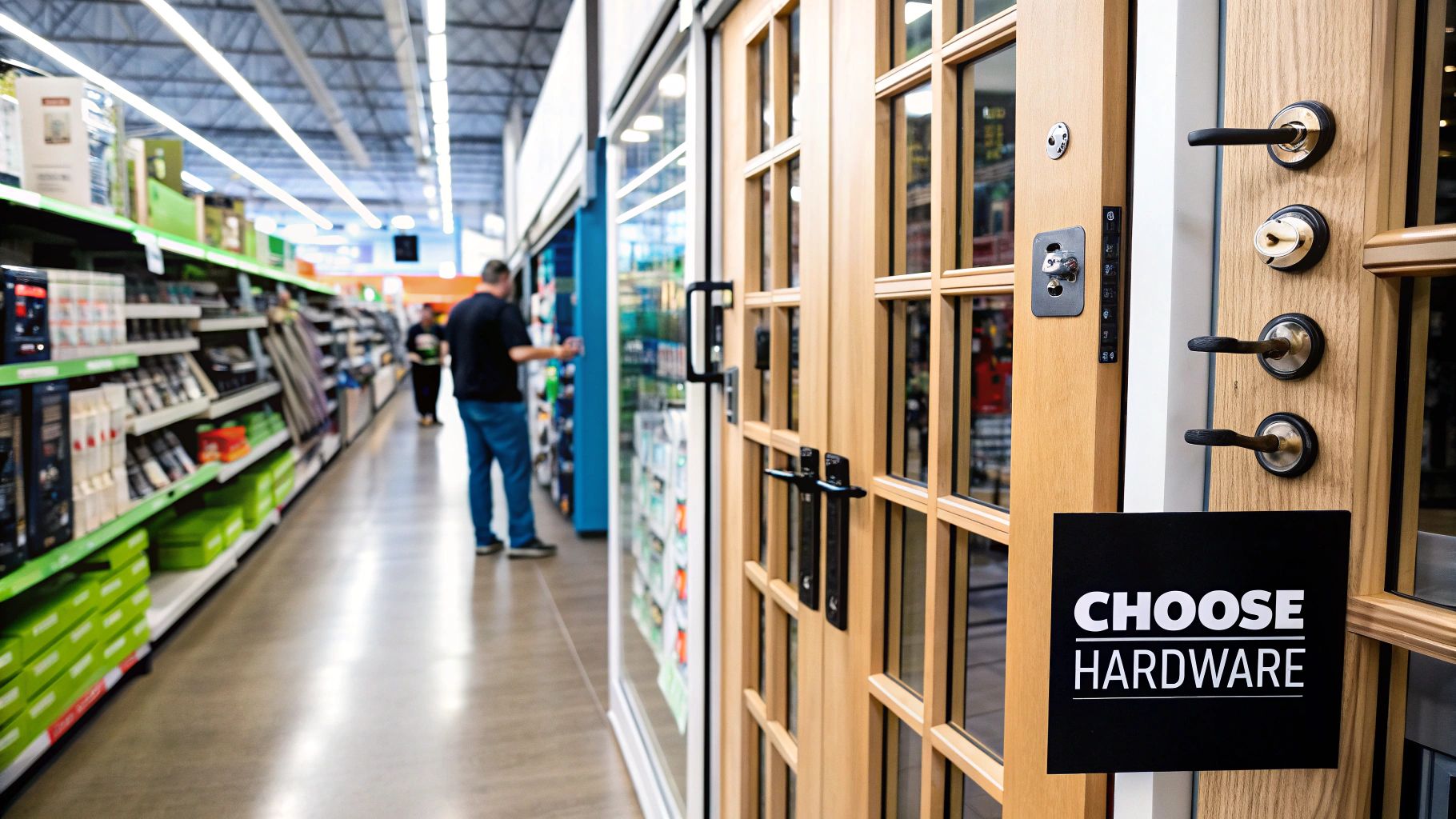
Security film is a strong, clear polyester sheet that adheres directly to your window. If the glass is struck, it will shatter, but the film’s powerful adhesive holds the dangerous shards together in the frame. This creates a tough barrier that is incredibly difficult for an intruder to breach quickly or quietly.
This delay is the film's biggest advantage. Instead of a fast, silent entry, a burglar faces a loud, frustrating struggle, often causing them to give up and flee.
Understanding Film Thickness (Mil Ratings)
The strength of security film is measured in "mils"—one-thousandth of an inch. The higher the mil rating, the tougher the film.
- 4–7 Mil Film: The ideal range for most homes. It provides excellent protection against smash-and-grab burglaries and prevents glass from scattering if accidentally broken.
- 8–14 Mil Film: This thicker grade offers more substantial protection, often used on commercial buildings or homes in high-risk areas. It provides a longer delay against a determined intruder.
- 15+ Mil Film: This is hurricane-grade or bomb-blast film, which is usually overkill for typical home security unless you live in an area prone to extreme weather.
For homeowners looking to boost day-to-day security, a film in the 4–8 mil range offers the perfect balance of effectiveness and cost. For the absolute best glass reinforcement, you could also explore options like specially engineered hurricane impact glass.
DIY Installation vs. Professional Services
Should you install the film yourself or hire a professional?
The DIY route can save money but requires patience. The process involves meticulously cleaning the window, cutting the film, applying it with a soapy water solution, and squeegeeing out all bubbles. Achieving a flawless finish is challenging.
Hiring a professional ensures a perfect application, often with a warranty. They have the experience and tools to do the job right, which is critical for both appearance and performance.
Key Takeaway: While DIY is cheaper upfront, a poor installation can compromise the film's effectiveness. If you're not confident, professional installation is a worthwhile investment.
Many security films also offer secondary benefits like UV protection. For more ideas on managing what comes through your windows, check out our guide on how to block sunlight from your windows.
Integrating Smart Technology for Modern Security
Physical barriers are only half the story when figuring out how to secure a window. Smart technology adds a proactive layer of defense, offering 24/7 monitoring and control from your smartphone. It turns your windows from passive entry points into active parts of your home security network.
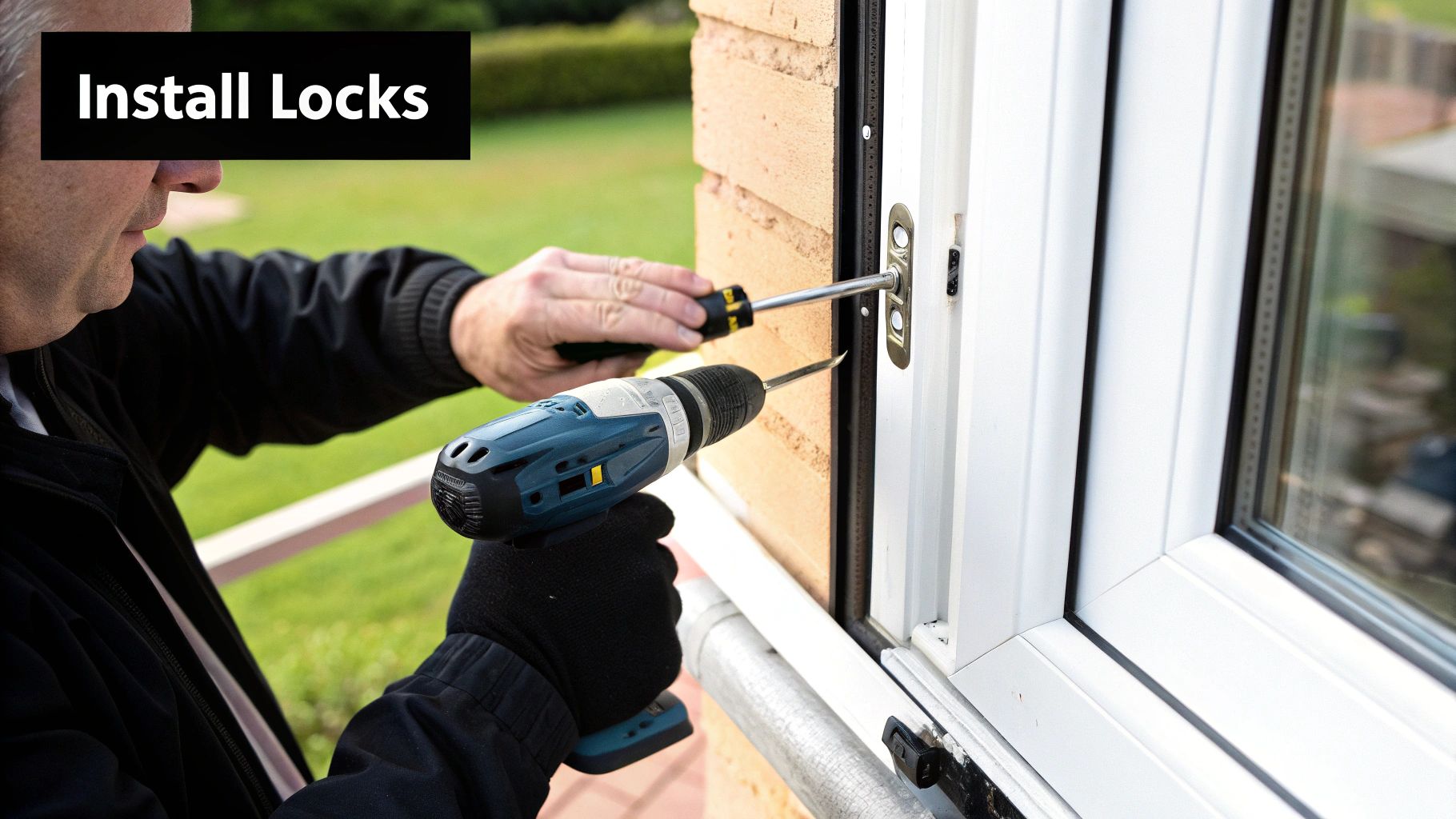
This modern approach moves beyond prevention to immediate detection. The moment a window is opened or glass breaks, you'll know about it instantly, no matter where you are.
Smart Sensors: The Eyes and Ears of Your Windows
The foundation of smart window security is a network of good sensors. These small devices detect specific types of interference and trigger an alarm or send an alert to your phone.
- Contact Sensors: The most common type, they come in two parts—one for the frame and one for the sash. When the window is opened, the connection is broken, and an alert is sent.
- Glass Break Sensors: These devices use a built-in microphone to listen for the specific acoustic frequency of shattering glass. A single sensor can often cover multiple windows in one room.
- Vibration Sensors: Also called shock sensors, they detect the physical impact or vibration of someone trying to force a window open. This can alert you to an attempted break-in before an intruder gets inside.
For a comprehensive approach, explore the best home security systems that integrate seamlessly with these window devices.
Automation Adds Another Layer of Security
Beyond alerts, automation can actively help secure your home. Smart blinds can be programmed to close on a schedule, creating the illusion that someone is home. Some systems even let you close all your blinds with a single tap as you leave.
Pro Tip: Integrate your window sensors with your smart lighting. If a window sensor is triggered at night, you can have lights in that room and around the house turn on instantly. It’s an incredibly powerful deterrent.
This level of automation is driving a huge market, fueled by consumer demand for smart-home solutions that improve security through remote control over windows and blinds.
Advanced Window Security Tactics for Maximum Protection
You've handled the basics—locks, sensors, and film. Now it's time to level up with heavy-duty solutions for vulnerable ground-floor or basement windows. These advanced tactics create physical barriers that are incredibly tough to breach.
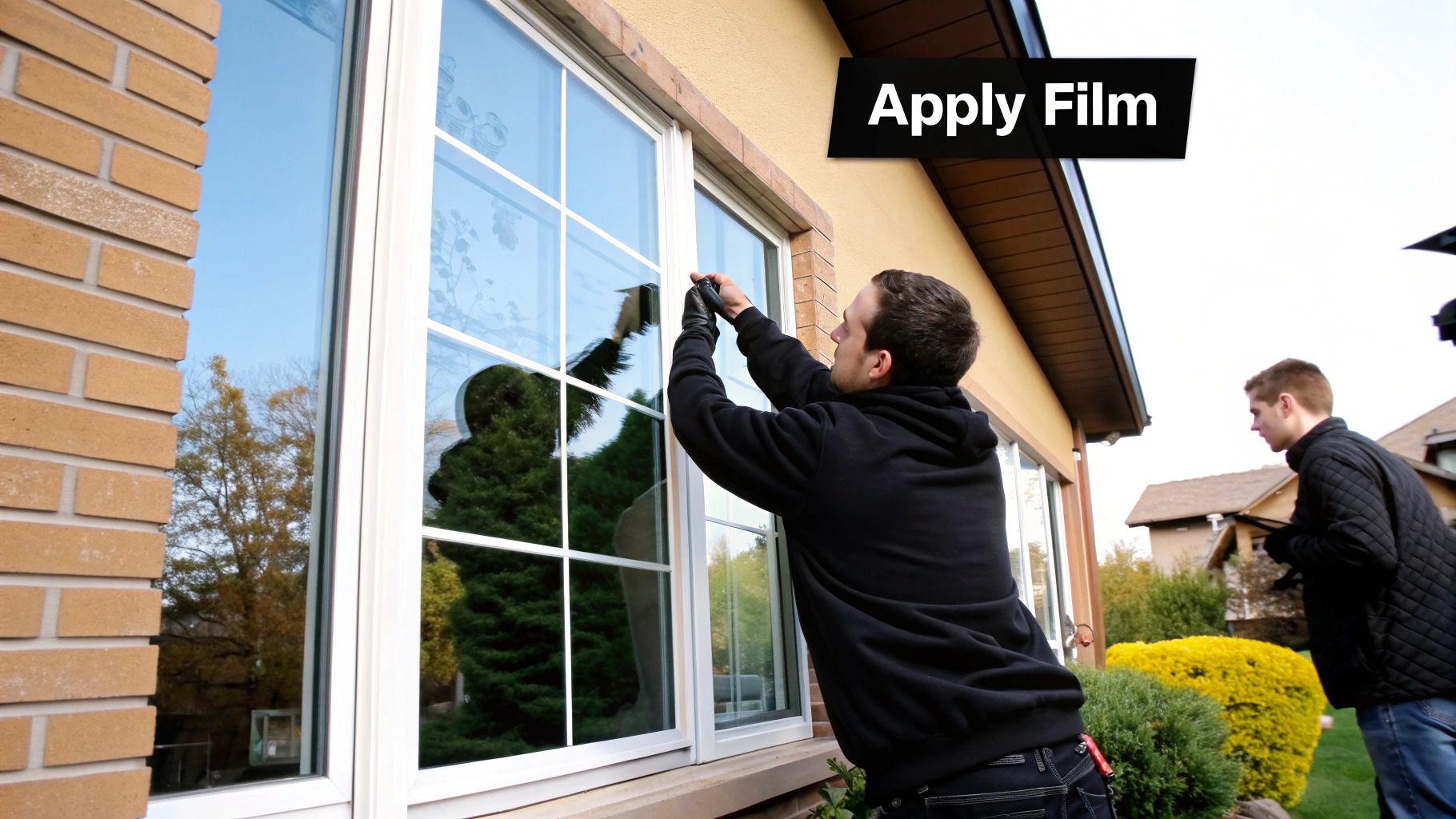
Upgrading to Security Bars and Grilles
Modern security bars and grilles are far from the ugly cages of the past and can add to your home's curb appeal while being exceptionally effective.
- Custom Designs: You can find options that match your home's architecture, from sleek, minimalist lines to ornate patterns.
- Emergency Egress: This is non-negotiable. Any bars on bedroom windows must have a quick-release mechanism for fire safety.
- Material Strength: Always choose solid steel. Hollow tubes can be bent or cut with surprising ease.
The biggest advantage of bars or grilles is that they scream "this house is not an easy target." A potential intruder will often take one look and move on.
Polycarbonate Glazing: A Shatterproof Alternative
For robust protection that's nearly invisible, consider swapping standard glass for polycarbonate panels. Polycarbonate is a type of thermoplastic that is an incredible 250 times more impact-resistant than glass while being just as clear. It's the same material used for riot shields.
This is a pricier option than security film, but it delivers the highest level of protection against brute-force attacks.
Laminated Security Glass
Another fantastic high-end option is laminated security glass. It works by sandwiching a tough layer of polyvinyl butyral (PVB) between two panes of glass. If struck, the glass may crack, but the PVB interlayer holds everything together, much like a car windshield.
This provides top-tier security and also offers significant noise reduction and UV filtering. Laminated glass is installed as a full window replacement, making it a permanent, integrated solution.
While fortifying your windows, don't overlook the power of privacy. Our article on why your home needs blackout curtains explains how preventing prying eyes from seeing inside adds another crucial security layer.
Frequently Asked Questions About How to Secure a Window
You have the strategies, but a few questions might still remain. Let's tackle some of the most common ones to help you move forward with confidence.
What is the cheapest way to secure windows?
The most budget-friendly way to secure windows is to ensure all factory-installed locks are working properly and are always used. Many break-ins are crimes of opportunity through an unlocked window. For a few extra dollars, you can add a dowel rod or "charley bar" in the track of a sliding window or install simple pin locks for a powerful physical barrier.
Are window security films really effective?
Yes, they are highly effective. Security film doesn't make glass unbreakable; its purpose is to buy you time and create noise. When a window with security film is struck, the glass shatters, but the adhesive holds the fragments together. This forces an intruder to make a loud, prolonged effort to get through, which is a powerful deterrent.
Do I need security bars on my windows?
Security bars provide the ultimate physical defense but aren't necessary for every window. They are best suited for your most vulnerable windows, such as those on the ground floor or in the basement, especially if they are hidden from street view. Modern designs can complement your home's architecture, but remember that any bars on a bedroom window must have a quick-release mechanism for fire escape.
How can I secure my windows without bars?
You can secure windows effectively without bars by layering other methods. Start by upgrading to high-quality keyed locks or secondary flip locks. Reinforce the glass with security window film (4-8 mil thickness is ideal for homes). Finally, install a smart security system with contact sensors and glass break detectors to provide instant alerts.
What is the best lock for a window?
The best lock depends on your window type. For double-hung or sliding windows, a keyed lock offers top-tier security, as it can't be opened from the inside without a key. For a strong secondary lock, pin locks or flip locks are excellent, affordable options. For casement windows, a multi-point locking system with a heavy-duty crank mechanism is most secure.
Of course, security isn't just about locks; privacy is a huge component. For a deep dive into window coverings, our guide on how to choose the right curtains for every room is packed with great ideas.
At Joey'z Shopping, we believe a beautiful home should also be a safe one. Explore our collection of stylish and functional window treatments to add that final layer of privacy and peace of mind to your home security plan. Visit us at https://joeyzshopping.com.
